
spglobal.com/ratings
Primary Credit
Analysts
Antonio Zellek, CFA
Mexico City
52
-55-5081-4484
antonio.zellek
@spglobal.com
Alejandra
Rodríguez
Ciudad de México
52
-55-5081-4460
alejandra.rodriguez1
@spglobal.com
José Coballasi
Ciudad de México
52
-55-5081-4414
jose.coballasi
@spglobal.com
See the last
page for the full
contact list.
Structured Finance
Mexican RMBS: Navigating
Choppy Waters
Sept. 14, 2023
This report does not constitute a rating action
Mexico's housing market has been facing significant challenges since 2018, including relatively
slow economic growth, historically low government housing subsidies, supply constraints, and
high inflation. This has led to declining housing starts over the past five years, which in turn has
hampered the pace of mortgage origination by the country's two government-related mortgage
entities: Instituto del Fondo Nacional de la Vivienda para los Trabajadores (Infonavit) and
Fondo
de la Vivienda del Instituto de Seguridad y Servicios Sociales de los Trabajadores del Estado
(Fovissste) -- though the latter has recorded more stable origination levels.
The persistent high interest rates also resulted in tighter spreads between mortgage loan
interest rates and market benchmark rates, which slowed the issuance of new residential
mortgage-backed securities (RMBS) transactions in Mexico. As a result, Infonavit, Fovissste, and
Fideicomiso Irrevocable F/2061 constituido en Banco Invex S.A., Institución de Banca Múltiple,
Invex Grupo Financiero (Fhipo) haven't issued any new RMBS transactions during the past 18
months. S&P Global Ratings expects this trend to continue through year end and the first half of
2024.
We also expect the Mexican RMBS transactions we rate to remain stable and continue repaying
as expected. However, credit enhancement levels could decline for some Infonavit transactions if
the nonperforming portfolio deteriorates beyond our expectation and we raise our expected loss
assumptions as a result (considering their target overcollateralization payment schemes).
Key Takeaways
• The Mexican RMBS market continues to see mixed transaction performance and no
new issuance due to high interest rates and other challenging market conditions.
• We expect this trend to continue through year end and possibly persist in the first half
of 2024 due to the upcoming presidential election in June 2024.
• We also expect the Mexican RMBS transactions we rate to maintain stable performance
and continue repaying as expected, though portfolio deterioration could pressure the
credit enhancement on certain Infonavit transactions.
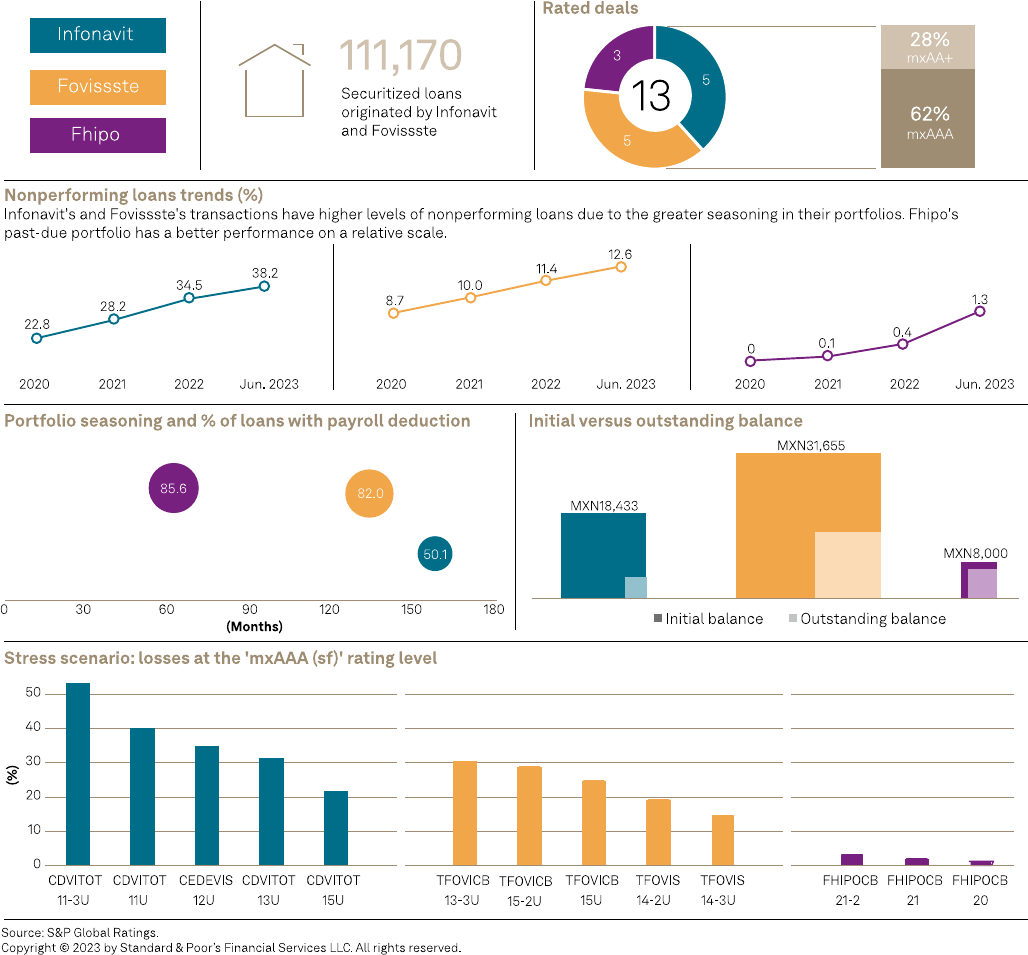
Mexican RMBS: Navigating Choppy Waters
spglobal.com/ratings
Sept. 14, 2023
2
We provide more in-depth analyses of the three largest Mexican mortgage originators we rate in
the sections below. Note that Infonavit originates mortgages for private sector employees, while
Fovissste originates mortgages for public sector employees. Fhipo is a mortgage real estate
investment trust (REIT) whose portfolios consists of loans co-financed by Infonavit, Fovissste,
and other entities.
Chart 1
Mexican RMBS transactions
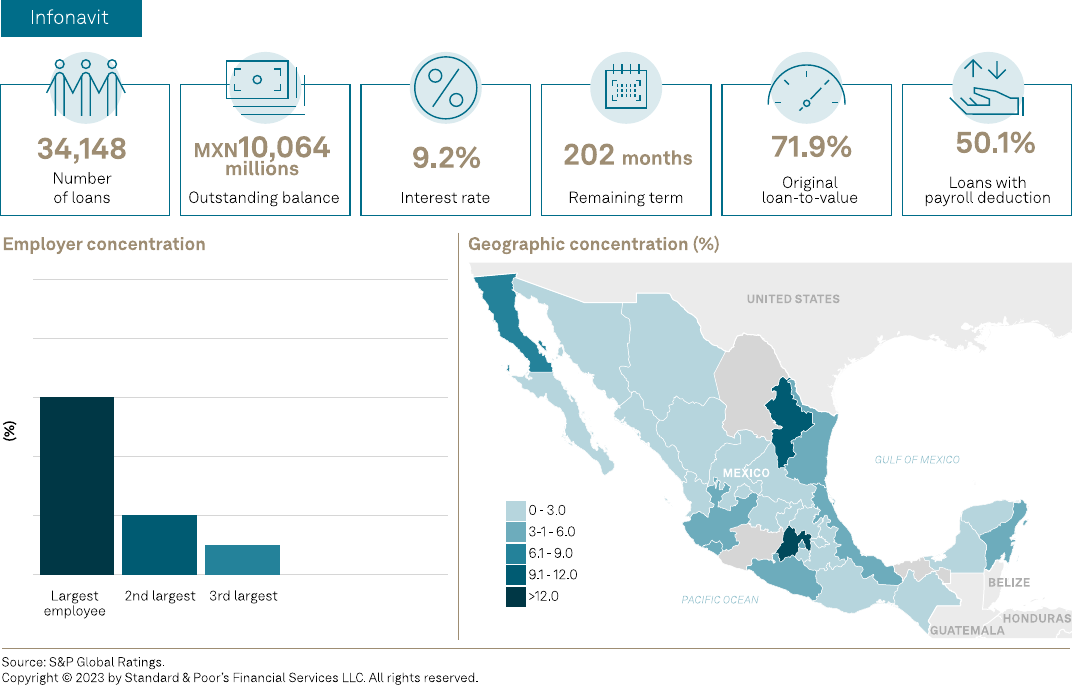
Mexican RMBS: Navigating Choppy Waters
spglobal.com/ratings
Sept. 14, 2023
3
Infonavit
Chart 2
Characteristics of the securitized portfolios
The transactions' current credit enhancement levels are sufficient to support the ratings.
Infonavit-originated RMBS transactions have shown continuous performance deterioration since
2018. The portion of borrowers whose payments are collected through payroll discount have
declined as the portfolios seasoned. However, we believe the transactions' current credit
enhancement levels, which are in the form of overcollateralization and excess spread, mitigate
this risk, and remain sufficient to support the current ratings.
Further collateral performance deterioration could pressure existing credit protections. The
five Infonavit transactions we currently rate (see Appendix) continue to amortize as expected,
with an average outstanding balance of 24% of the total issued amount as of June 2023. Twenty-
one Infonavit transactions were paid off during the past five years.
The transactions have pro rata payment structures through which the notes are amortized to
maintain credit enhancement at the target levels. However, if nonperforming loans increase
beyond our expectations, the current credit enhancement levels may not be sufficient to
withstand the updated stress scenarios.
0
2
4
6
8
10
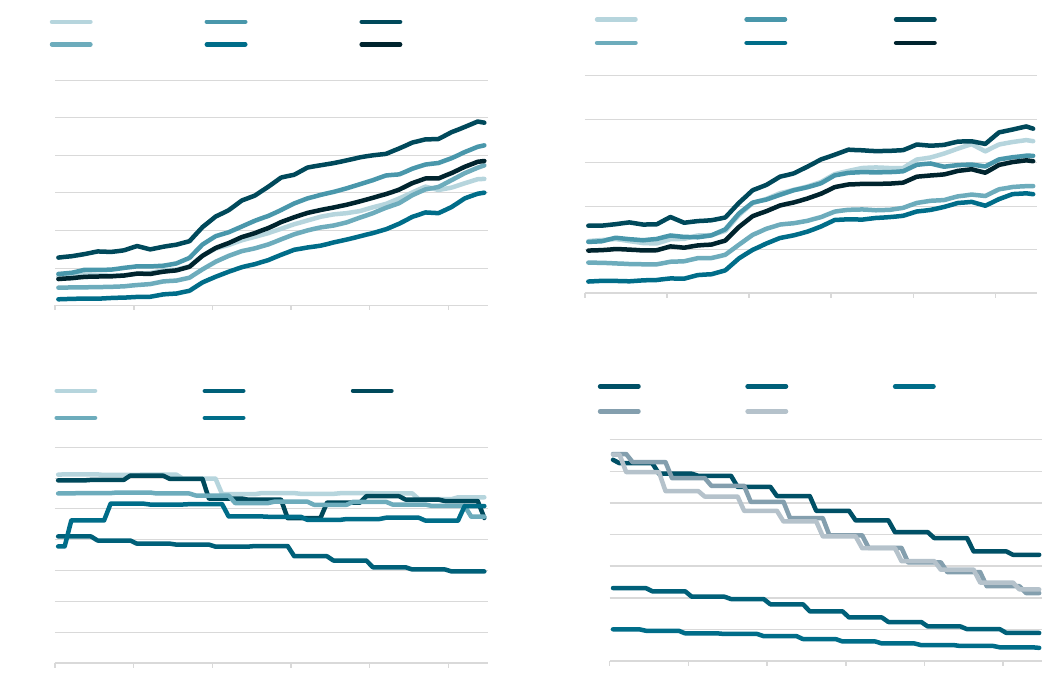
Mexican RMBS: Navigating Choppy Waters
spglobal.com/ratings
Sept. 14, 2023
4
Nonperforming loans continue to increase as the number of borrowers with payroll deductions
decline. Nonperforming loans, which are measured as delinquency greater than 90 days as a
percentage of the outstanding balance of the portfolios, rose to 38.4% of Infonavit's portfolio as
of June 2023 from 31.7% a year earlier, according to the mortgage servicers' reports. However,
when measured as a percentage of the initial balance of the portfolios, nonperforming loans
represented 15.2% of Infonavit's portfolio in June, up from 13.8% a year earlier. This deterioration
reflects the decline in the percentage of borrowers employed in the private sector, which fell to
47.7% in June 2023 from 53.6% a year earlier.
Certain trigger events could mitigate the downside risk. The transaction structures include
early amortization events related to the securitized portfolios' performance, which could mitigate
the downside risk. If these events are triggered, the payment waterfalls would change to
sequential and the interests on the subordinated classes would be capitalized, which could
quickly deleverage the transactions. Given the observed performance so far, we would expect
some transactions to change their payment waterfall in the next 12 months due to this early
amortization events.
Chart 3
Performance indicators
Nonperforming loans as a % of outstanding balance
Nonperforming loans as a % of initial balance
Overcollateralization
Outstanding balance
Source: S&P Global Ratings.
Copyright © 2023 by Standard & Poor’s Financial Services LLC. All rights reserved..
0%
10%
20%
30%
40%
50%
60%
Jan-18 Jan-19 Jan-20 Jan-21 Jan-22 Jan-23
CEDEVIS 12U CDVITOT 11U CDVITOT 11-3U
CDVITOT 13U CDVITOT 15U Infonavit
0%
5%
10%
15%
20%
25%
Jan-18 Jan-19 Jan-20 Jan-21 Jan-22 Jan-23
CEDEVIS 12U CDVITOT 11U CDVITOT 11-3U
CDVITOT 13U CDVITOT 15U Infonavit
0%
5%
10%
15%
20%
25%
30%
35%
Jan-18 Jan-19 Jan-20 Jan-21 Jan-22 Jan-23
CEDEVIS 12U CDVITOT 11U CDVITOT 11-3U
CDVITOT 13U CDVITOT 15U
-
500
1,000
1,500
2,000
2,500
3,000
3,500
Jan-18 Jan-19 Jan-20 Jan-21 Jan-22 Jan-23
(Mil. MXN)
CEDEVIS 12U CDVITOT 11U CDVITOT 11-3U
CDVITOT 13U CDVITOT 15U
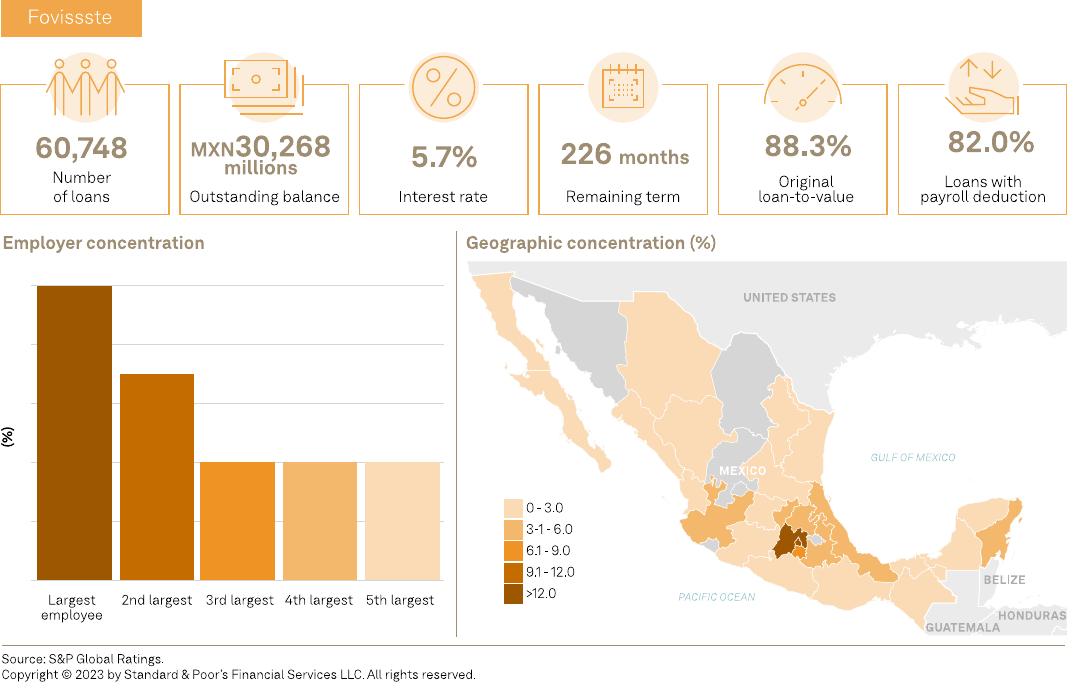
Mexican RMBS: Navigating Choppy Waters
spglobal.com/ratings
Sept. 14, 2023
5
Fovissste
Chart 4
Characteristics of the securitized portfolios
Borrowers' employment stability tempers rising nonperforming loan levels. Fovissste-
originated transactions have also seen higher levels of nonperforming loans, though at a lower
rate than Infonavit. This mainly reflects the public sector's greater employment stability relative
to the private sector. The Fovissste transactions' full-turbo payment structures (in which all
inflows are destined to amortize the notes after paying expenses and interests) have also allowed
them to increase their credit overcollateralization levels.
The transactions continue to benefit from increasing overcollateralization and greater
performance stability. The five Fovissste-originated and serviced transactions we currently rate
(see Appendix) have solid overcollateralization levels that continue to increase due to their full-
turbo amortization scheme (in which all inflows from collections after covering expenses and
interest are used to amortize the unpaid balance of the notes). Overcollateralization levels rose
24% year over year, on average, as of June 2023.
0
2
4
6
8
10
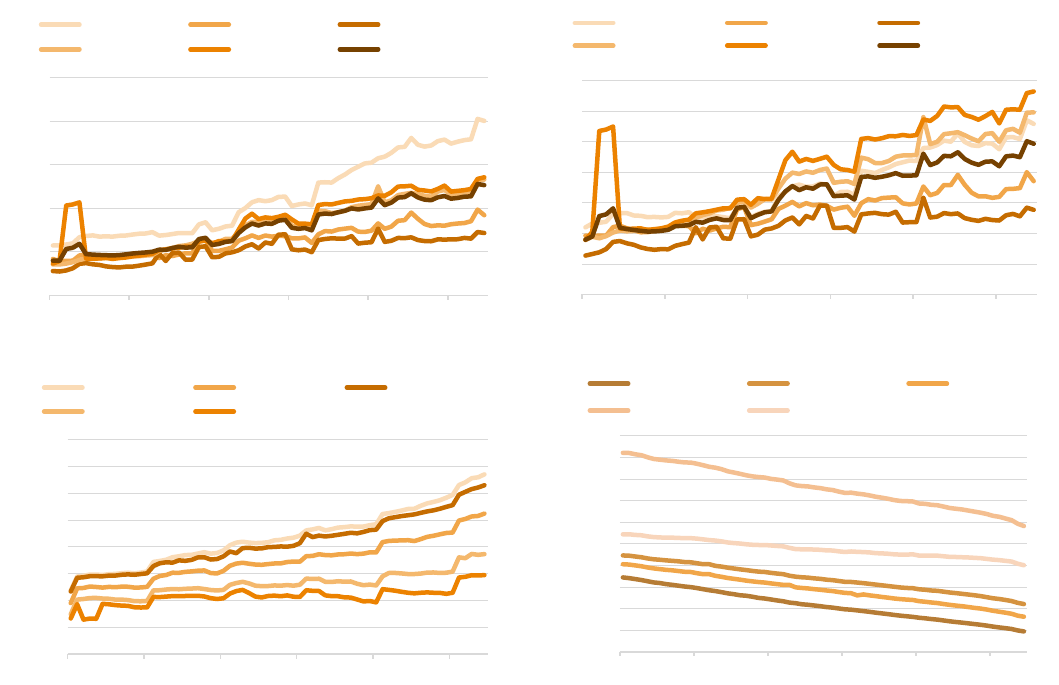
Mexican RMBS: Navigating Choppy Waters
spglobal.com/ratings
Sept. 14, 2023
6
Nonperforming loans increased due to stronger borrower characteristics. Nonperforming loans
rose, on average, to 9.8% of the portfolios as of June 2023 from 9.0% a year earlier. However,
these levels are within our expectations, and we believe they reflect the greater employment
stability in the public sector compared to the private sector.
We expect the transactions' performance to remain stable, based on their increasing
overcollateralization levels and the greater stability in the underlying portfolios' performance.
Before 2021, Fovissste had taken the lead in new issuance volume, issuing one or two
transactions per year. However, the fund stopped securitizing its portfolio in 2021 due to the high
interest rate environment. As a result, we don't expect Fovissste to participate in the
securitization market for the remainder of this year.
Chart 5
Performance indicators
Nonperforming loans as a % of outstanding balance
Nonperforming loans as a % of initial balance
Overcollateralization
Outstanding balance
Source: S&P Global Ratings.
Copyright © 2023 by Standard & Poor’s Financial Services LLC. All rights reserved..
0%
5%
10%
15%
20%
25%
Jan-18 Jan-19 Jan-20 Jan-21 Jan-22 Jan-23
TFOVICB 13-3U TFOVIS 14-2U TFOVIS 14-3U
TFOVICB 15U TFOVICB 15-2U Fovissste
0%
2%
4%
6%
8%
10%
12%
14%
Jan-18 Jan-19 Jan-20 Jan-21 Jan-22 Jan-23
TFOVICB 13-3U TFOVIS 14-2U TFOVIS 14-3U
TFOVICB 15U TFOVICB 15-2U Fovissste
0%
10%
20%
30%
40%
50%
60%
70%
80%
Jan-18 Jan-19 Jan-20 Jan-21 Jan-22 Jan-23
TFOVICB 13-3U TFOVIS 14-2U TFOVIS 14-3U
TFOVICB 15U TFOVICB 15-2U
-
1,000
2,000
3,000
4,000
5,000
6,000
7,000
8,000
9,000
10,000
Jan-18 Jan-19 Jan-20 Jan-21 Jan-22 Jan-23
(Mil. MXN)
TFOVICB 13-3U TFOVIS 14-2U TFOVIS 14-3U
TFOVICB 15U TFOVICB 15-2U
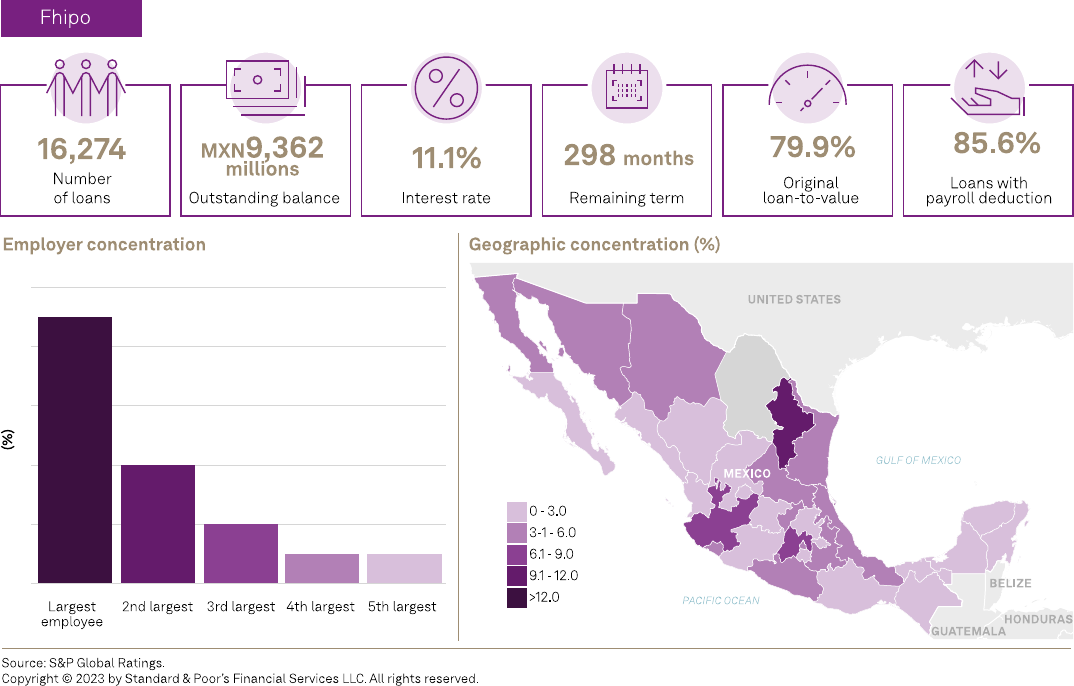
Mexican RMBS: Navigating Choppy Waters
spglobal.com/ratings
Sept. 14, 2023
7
Fhipo
Chart 6
Characteristics of the securitized portfolios
Favorable credit quality and strong credit coverage support the ratings. Unlike Infonavit and
Fovissste, Fhipo has seen very low levels (approximately 1%) of nonperforming loans and stable
credit enhancement levels. This is likely due to the greater credit quality of the securitized
portfolios, which consists of Mexican peso-denominated loans originated jointly with Infonavit.
The transactions consist of better credit quality loans with lower expected loss levels. S&P
Global Ratings rates three transactions that are originated by Fhipo (see Appendix). The
transactions are backed by the portion of a portfolio of Mexican peso-denominated residential
mortgage loans that were originated jointly with Infonavit under Infonavit's Más Crédito program.
The program provides financing for workers who have already paid down a loan with Infonavit and
have shown adequate payment behavior. The loans were originated in Mexican pesos and have
better credit quality relative to those originated by Infonavit and Fovissste, based on their lower
expected loss levels.
We expect the transactions' good performance trend to continue in the near term. The Fhipo
transactions were issued in 2020 and 2021, and thus have a short performance track record than
the other Mexican RMBS transactions we rate. However, on a relative scale, the past-due
portfolio levels have a better performance trend compared to traditional Infonavit loans.
According to the servicer's reports, the past-due portfolio has remained at very low levels, with
0
2
4
6
8
10
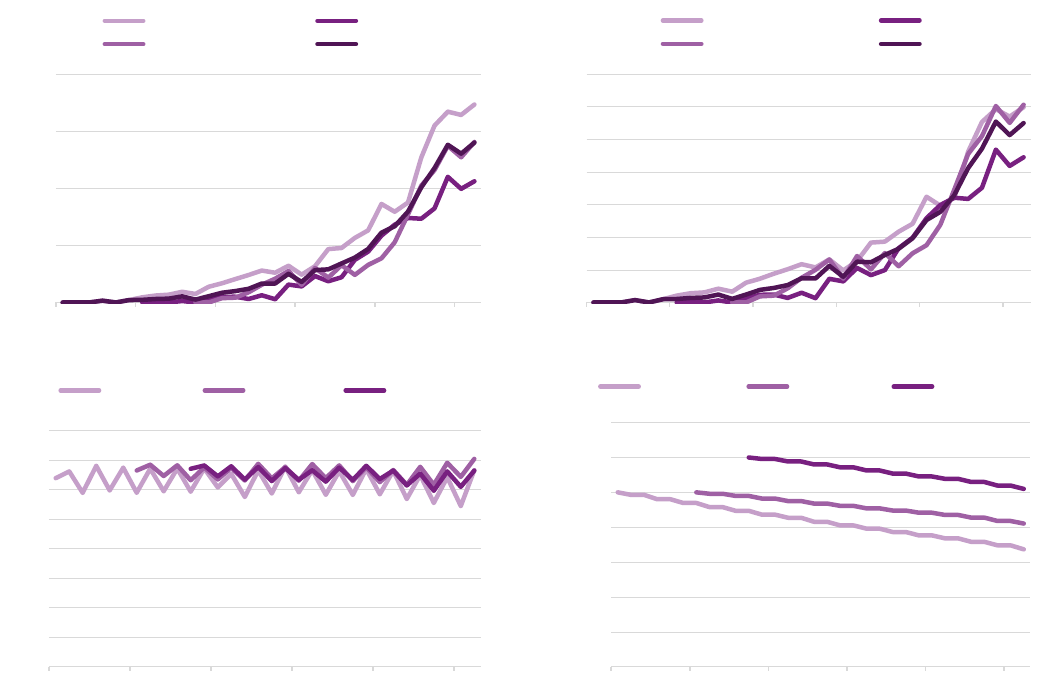
Mexican RMBS: Navigating Choppy Waters
spglobal.com/ratings
Sept. 14, 2023
8
nonperforming loans levels at 1.1% as of June 2023, compared with 0.25% a year earlier. We
believe the transactions' credit protection levels continue to support the ratings, and we expect
the transactions' performance to remain stable over the next 12 months.
We also expect no new issuance through year end. In 2020 and 2021, Fhipo was an active
participation in the RMBS securitization market in terms of new issuances. However, the trust
hasn't issued any new transactions since then. As a result, given current market conditions, we
don't expect any new issuances for the remainder of this year.
Chart 7
Performance indicators
Nonperforming loans as a % of outstanding balance
Nonperforming loans as a % of initial balance
Overcollateralization
Outstanding balance
Source: S&P Global Ratings.
Copyright © 2023 by Standard & Poor’s Financial Services LLC. All rights reserved.
0.0%
0.5%
1.0%
1.5%
2.0%
Nov-20 May-21 Nov-21 May-22 Nov-22 May-23
FHIPOCB 20 FHIPOCB 21
FHIPOCB 21-2 Fhipo
0.0%
0.2%
0.4%
0.6%
0.8%
1.0%
1.2%
1.4%
Nov-20 May-21 Nov-21 May-22 Nov-22 May-23
FHIPOCB 20 FHIPOCB 21
FHIPOCB 21-2 Fhipo
0%
2%
4%
6%
8%
10%
12%
14%
16%
Nov-20 May-21 Nov-21 May-22 Nov-22 May-23
FHIPOCB 20 FHIPOCB 21 FHIPOCB 21-2
-
500
1,000
1,500
2,000
2,500
3,000
3,500
Nov-20 May-21 Nov-21 May-22 Nov-22 May-23
(Mil. MXN)
FHIPOCB 20 FHIPOCB 21 FHIPOCB 21-2
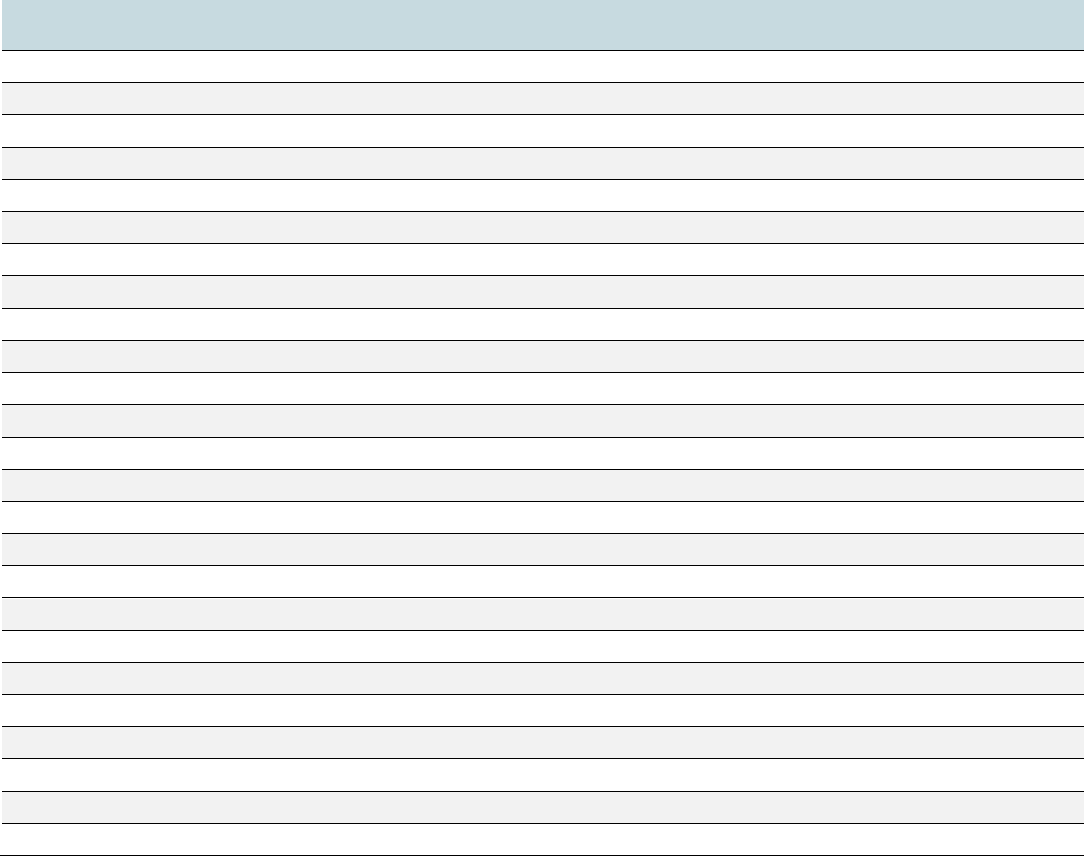
Mexican RMBS: Navigating Choppy Waters
spglobal.com/ratings
Sept. 14, 2023
9
Appendix
The table below shows the Mexican RMBS transactions currently rated by S&P Global Ratings.
Mexican RMBS transactions rated by S&P Global Ratings
Transactions Type Current rating Legal maturity date Outstanding balance
(mil. UDIs/MXN)(i)
Fovissste - Bursatilizaciones de Hipotecas Residenciales
TFOVICB 13-3U Senior mxAAA (sf) Nov. 27, 2043 UDI122.06
TFOVIS 14-2U Senior mxAAA (sf) March 27, 2044 UDI284.79
TFOVIS 14-3U Senior mxAAA (sf) Sept. 27, 2044 UDI209.66
TFOVICB 15U Senior mxAAA (sf) Jan. 27, 2045 UDI748.75
TFOVICB 15-2U Senior mxAAA (sf) May 26, 2045 UDI511.29
Infonavit - Bursatilizaciones de Hipotecas Residenciales
CEDEVIS 12U Senior mxAAA (sf) Feb. 20, 2040 UDI193.29
Constancia Preferente Subordinated mxAA+ (sf) Feb. 20, 2040 UDI24.16
Infonavit Total - Bursatilizaciones de Hipotecas Residenciales
CDVITOT 11U Senior mxAAA (sf) July 20, 2039 UDI47.32
CDVITOT 11-2U Subordinated mxAA+ (sf) July 20, 2039 UDI3.00
Constancia Preferente Subordinated mxAA+ (sf) July 20, 2039 UDI2.50
CDVITOT 11-3U Senior mxAAA (sf) Dec. 20, 2039 UDI23.87
Constancia Preferente Subordinated mxAA+ (sf) Dec. 20, 2039 UDI2.91
CDVITOT 13U Senior mxAAA (sf) Oct. 21, 2041 UDI123.59
CDVITOT 13-2U Subordinated mxAA+ (sf) Oct. 21, 2041 UDI7.13
Constancia Preferente Subordinated mxAA+ (sf) Oct. 21, 2041 UDI7.23
CDVITOT 15U Senior mxAAA (sf) Sept. 21, 2043 UDI130.99
CDVITOT 15-2U Subordinated mxAA+ (sf) Sept. 21, 2043 UDI8.76
Constancia Preferente Subordinated mxAA+ (sf) Sept. 21, 2043 UDI6.00
Fhipo - Bursatilizaciones de Hipotecas Residenciales
FHIPOCB 20 Senior mxAAA (sf) Dec. 15, 2050 MXN1,681.95
FHIPOCB 21 Senior mxAAA (sf) June 5, 2051 MXN2,052.06
FHIPOCB 21-2 Senior mxAAA (sf) Oct. 12, 2051 MXN2,549.42
(i)Outstanding balance as of June 2023. 1 UDI = MXN7.766768 as of June 30, 2023. MXN--Mexican Pesos. UDI--Unidad de Inversion (a Mexican inflation-linked unit).

Mexican RMBS: Navigating Choppy Waters
spglobal.com/ratings
Sept. 14, 2023
10
Related Research
• Financiamiento Estructurado en América Latina: Estadísticas de seguimiento, Aug. 10, 2023.
• Credit Conditions Emerging Markets Q3 2023: Inflation Peaked, Risks Remain, June 27, 2023
• Análisis Detallado: Instituto del Fondo Nacional de la Vivienda para los Trabajadores
(Infonavit), June 12, 2023.
• Análisis Actualizado: Fondo de la Vivienda del Instituto de Seguridad y Servicios Sociales de
los Trabajadores del Estado (Fovissste), Jan. 5, 2023.
Mexican RMBS: Navigating Choppy Waters
spglobal.com/ratings
Sept. 14, 2023
11
Contact List
Primary credit analyst
Primary credit analyst
Primary credit analyst
Antonio Zellek, CFA
Mexico City
+52
-55-5081-4484
antonio.zellek@spglobal.com
Alejandra Rodriguez
Mexico City
+52
-55-5081-4460
alejandra.rodriguez1@spglobal.com
Jose Coballasi
Mexico City
+52
-55-5081-4414
jose.coballasi@spglobal.com
Primary credit analyst
Analytical manager
Daniela Ragatuso
Mexico City
+52
-55-5081-4437
Leandro de Albuquerque
São Paulo
+55
-11-3039-9729
leandro.albuquerque@spglobal.com

Mexican RMBS: Navigating Choppy Waters
spglobal.com/ratings
Sept. 14, 2023
12
Copyright © 2023 by Standard & Poor's Financial Services LLC. All rights reserved.
No content (including ratings, credit
-related analyses and data, valuations, model, software or other application or output therefrom) or any part thereof (Content) may
be modified, reverse engineered, reproduced or distributed in any form by any means, or
stored in a database or retrieval system, without the prior written permission of
Standard & Poor’s Financial Services LLC or its affiliates (collectively, S&P). The Content shall not be used for any unlawfu
l or unauthorized purposes. S&P and any third-
pa
rty providers, as well as their directors, officers, shareholders, employees or agents (collectively S&P Parties) do not guarantee the accuracy, completeness, timeliness
or availability of the Content. S&P Parties are not responsible for any errors or omis
sions (negligent or otherwise), regardless of the cause, for the results obtained from
the use of the Content, or for the security or maintenance of any data input by the user. The Content is provided on an “as i
s” basis. S&P PARTIES DISCLAIM ANY AND ALL
E
XPRESS OR IMPLIED WARRANTIES, INCLUDING, BUT NOT LIMITED TO, ANY WARRANTIES OF MERCHANTABILITY OR FITNESS FOR A PARTICULAR PURPOSE OR USE,
FREEDOM FROM BUGS, SOFTWARE ERRORS OR DEFECTS, THAT THE CONTENT’S FUNCTIONING WILL BE UNINTERRUPTED OR THAT THE CONTE
NT WILL OPERATE WITH
ANY SOFTWARE OR HARDWARE CONFIGURATION. In no event shall S&P Parties be liable to any party for any direct, indirect, incide
ntal, exemplary, compensatory,
punitive, special or consequential damages, costs, expenses, legal fees, or los
ses (including, without limitation, lost income or lost profits and opportunity costs or losses
caused by negligence) in connection with any use of the Content even if advised of the possibility of such damages.
Credit
-related and other analyses, including ratings, and statements in the Content are statements of opinion as of the date they are expressed and not statements of
fact. S&P’s opinions, analyses and rating acknowledgment decisions (described below) are not recommendations to purchase, hol
d, or sell any securities or to make any
investment decisions, and do not address the suitability of any security. S&P assumes no obligation to update the Content fol
lowing publication in any form or format.
The Content should not be relied on and is not a substitu
te for the skill, judgment and experience of the user, its management, employees, advisors and/or clients when
making investment and other business decisions. S&P does not act as a fiduciary or an investment advisor except where registe
red as such. While S&P has obtained
information from sources it believes to be reliable, S&P does not perform an audit and undertakes no duty of due diligence or
independent verification of any information
it receives. Rating
-related publications may be published for a variety of reasons that are not necessarily dependent on action by rating committees, including, but not
limited to, the publication of a periodic update on a credit rating and related analyses.
To the extent that regulatory authorities allow a rating agency to
acknowledge in one jurisdiction a rating issued in another jurisdiction for certain regulatory purposes,
S&P reserves the right to assign, withdraw or suspend such acknowledgment at any time and in its sole discretion. S&P Parties
disclaim any duty whatsoever arising out
of the assignment, withdrawal or suspension of an acknowledgment as well as any liability for any damage alleged to have been
suffered on account thereof.
S&P keeps certain activities of its business units separate from each other in order
to preserve the independence and objectivity of their respective activities. As a result,
certain business units of S&P may have information that is not available to other S&P business units. S&P has established pol
icies and procedures to maintain the
conf
identiality of certain non-public information received in connection with each analytical process.
S&P may receive compensation for its ratings and certain analyses, normally from issuers or underwriters of securities or fro
m obligors. S&P reserves the right to
disseminate its opinions and analyses. S&P's public ratings and analyses are made available on its Web sites, www.spglobal.co
m/ratings (free of charge), and
www.ratingsdirect.com (subscription), and may be distributed through other means, including v
ia S&P publications and third-party redistributors. Additional information
about our ratings fees is available at
www.spglobal.com/usratingsfees.
STANDARD & POOR’S, S&P and RATINGSDIRECT are
registered trademarks of Standard & Poor’s Financial Services LLC.
